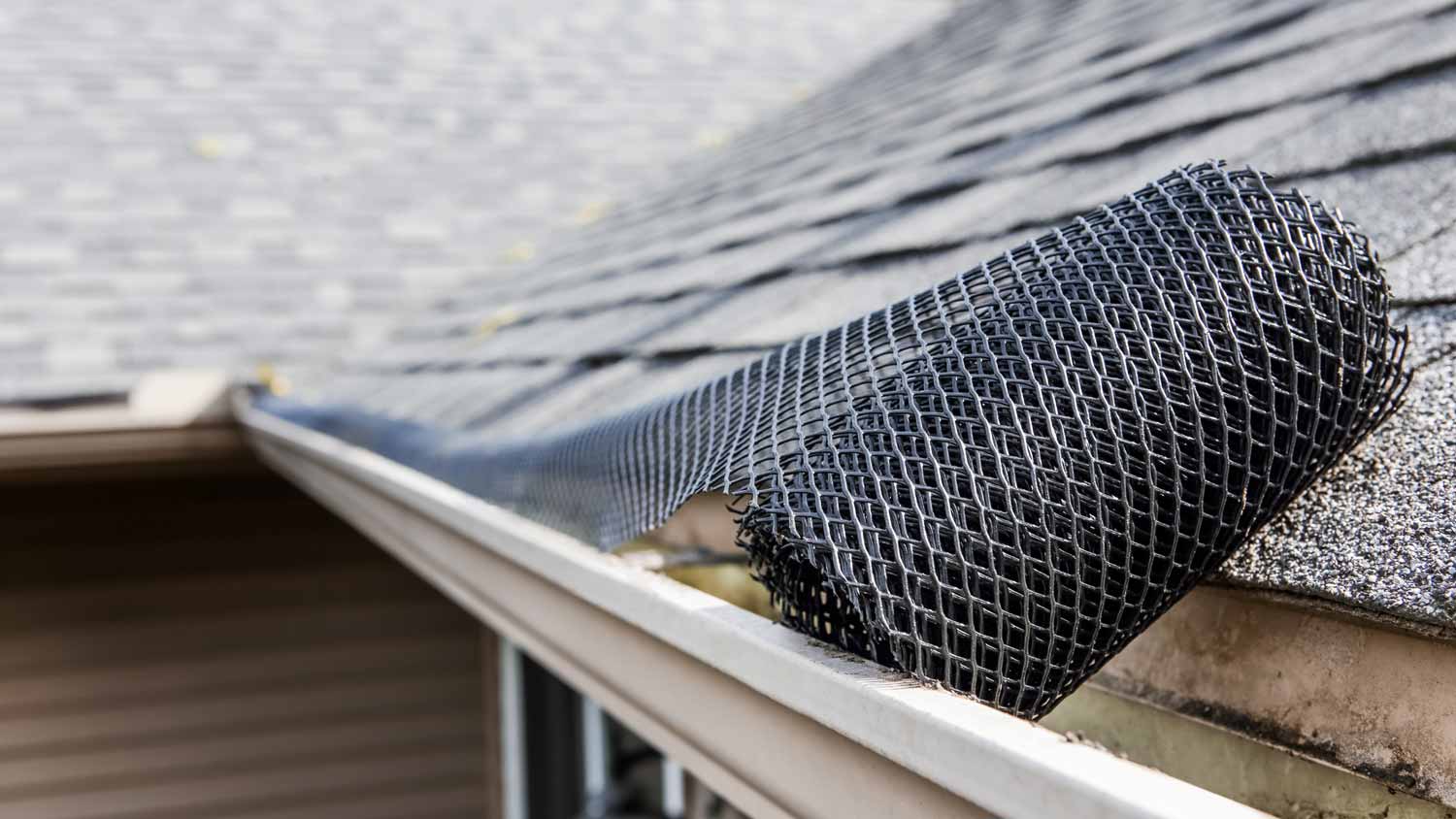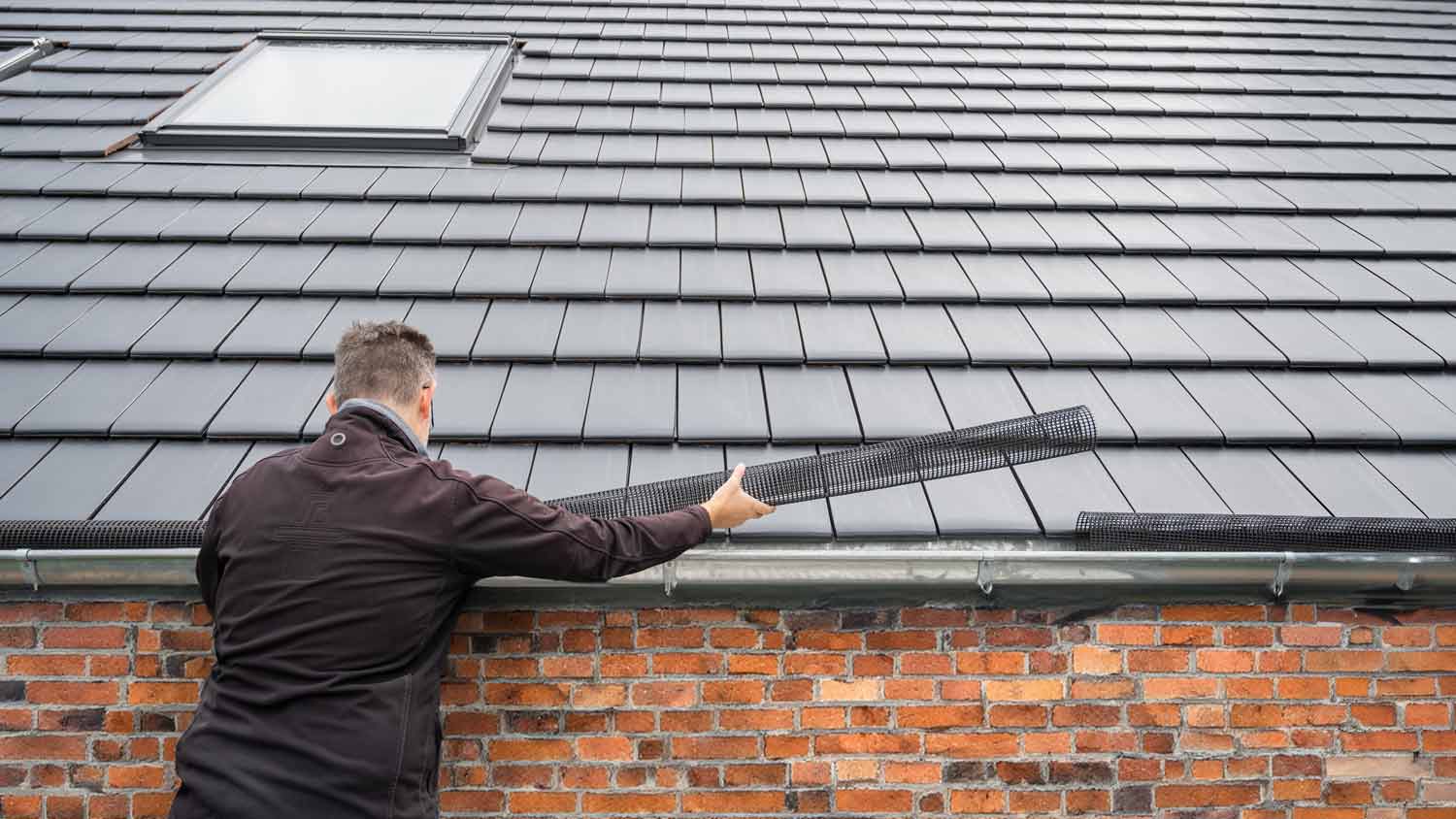
This guide will give you an idea of how much you can expect to pay when getting new seamless gutters installed when accounting for removal, labor, and different gutter materials.
Say goodbye to excess debris with micro mesh gutter guards


Micro mesh gutter guards are extremely durable and long-lasting, with a life span of about 20 years.
With holes as tiny as 30 to 50-micron, micro mesh prevents the smallest pieces of debris from entering.
Keeping your gutters debris-free with micro mesh prevents mold and pest infestations and extends the life of the gutters.
You can install micro mesh gutter guards yourself if you have experience, but it’s a job best left to the pros.
Spending a sunny afternoon cleaning the gutters doesn’t rank high on most homeowners’ to-do lists. But keeping out leaves, twigs, and other debris helps prevent mold growth and pest infestation. If you’re ready to ditch this task altogether, you can install gutter guards. Before making an investment in a gutter protection system, let’s take a look at the pros and cons of micro mesh gutter guards and see if they’re the right solution for your home.
When taking on this project, expect questions only a pro can answer. With our network of local pros, you'll get the job done and your questions answered—without the hassle and stress of doing it yourself.
Micro mesh gutter guards are screens that fit tightly over gutters and have small holes for filtering out debris, such as leaves and twigs, but still allow rainwater to enter. Water molecules stick to the tiny openings in the guard’s micro mesh screen and are drawn through its frame into the gutter. This gutter guard system blocks the smallest pieces of debris from getting inside while allowing rainwater to freely move through gutters and out the downspouts.
Micro mesh gutter guards are available in aluminum, plastic, and stainless steel, with stainless steel being the most durable and long-lasting material. When properly installed, homeowners won’t have to worry about gutter cleaning, which is the main advantage of gutter guards.

Micro mesh gutter guards—and gutter guards in general—are often worth it because they are so durable. Stainless steel in particular does not rust and can last 20 years or more. Some micro mesh guards have holes as small as 30 to 50-micron, which draws rainwater in but leaves even the smallest pieces of debris out.
Micro mesh guards prevent debris from getting trapped in the system, ultimately extending the life of the gutters. Otherwise, a clogged gutter can leave dirt, grime, and excess water sitting there, which can corrode the gutter. Micro mesh guards also prevent pest infestations, mold, and ice dams in colder climates.
Most micro mesh gutter guard manufacturers have warranties on their products of at least 20 years, with some offering lifetime warranties. They typically cover manufacturing defects but do not cover damage caused externally.

Micro mesh gutters can be expensive depending on the type of materials you choose, the length you need, and labor costs. Gutter guard installation costs between $1 and $10 per linear foot just for the materials, and they can cost between $650 and $2,400 or more when installed by a professional. Plastic micro mesh guards are cheaper than stainless steel, so you’ll be able to save on materials, but plastic is not as durable.
You can technically DIY gutter guards, but you should only attempt to install them if you have experience doing so. The guards are designed to slide under roof shingles and attach to the outside of the gutters with screws. If you’ve never done work like this before, it’s best to contact local gutter guard installation professionals, as the process can not only be challenging but dangerous.
Micro mesh guards will eliminate the majority of gutter debris, so you won’t have to clean your gutters frequently. However, there is still some maintenance—debris that collects on top of the gutters will need to be swept off on occasion, and you should still clean your gutters once a year.
If you are still not convinced that micro mesh is for you, there are several alternative types of gutter guards. Let’s take a look at the pros and cons of some other gutter guard systems.
Mesh gutter guards are nearly identical to micro mesh except the holes aren’t as small as those found in micro mesh guards. However, they are still durable and do block most debris. But you’ll probably need to clean out smaller particles from the system. They cost from $1 to $4 per linear foot.
A bottle brush gutter protection system costs between $3 and $4.50 per linear foot and is easy to install. This system is composed of round brushes that fit inside gutters and catch medium to large debris. While bottle brush guards can’t catch smaller pieces, they do significantly reduce gutter blockages.
With a price between $2 and $3.50 per linear foot, foam gutter guards are lightweight and easier to install but block only larger pieces of debris. They must be cleaned frequently to prevent mold.
Depending on the material, screen guards can be extremely inexpensive, costing between $0.50 and $3.50 per linear foot. Lightweight and easily installed, they have small holes across their width for filtering out medium and large debris. However, smaller items, like leaf fragments, can get through. Screens snap onto gutters while micro mesh gutter guards are more complex to install.
These gutter guards move debris instead of capturing it, while rainwater enters from a slotted opening between the gutter and the system. They cost between $3.50 and $10 per linear foot and require installation by a professional.
If you live in an area with high rainfall and several nearby trees drop small leaves or pine needles, micro mesh gutter guards may be right for you. They’ll help protect your gutter system from debris buildup and, thanks to less frequent cleanings, save you some money in the long run.
If you decide to take the plunge, contact a pro who does gutter work to install your micro mesh gutter guards.
From average costs to expert advice, get all the answers you need to get your job done.

This guide will give you an idea of how much you can expect to pay when getting new seamless gutters installed when accounting for removal, labor, and different gutter materials.

Gutter repair costs may not be as high as you think—but it depends on the type of damage you're addressing. Learn why you need to hire a gutter pro for this work.

Installing copper gutters adds beauty and value to your home. The cost of your project will depend on the size of your home, the size of your gutters, and the thickness of the material.

Vinyl gutters are solid, low-cost alternatives to expensive metals like steel and copper. Learn what makes up the total project cost for installing them—and where you can save.

If you need to get new gutters for your home, this guide to the pros and cons of aluminum gutters will help you decide if this affordable gutter option is right for you.

Learn the cost to install downspouts on your home's rain gutter system based on materials, quantity, and other factors.